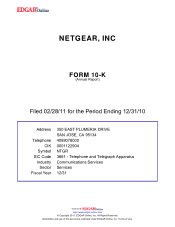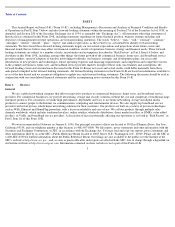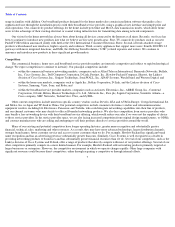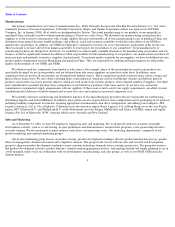Netgear 2010 Annual Report Download - page 9
Download and view the complete annual report
Please find page 9 of the 2010 Netgear annual report below. You can navigate through the pages in the report by either clicking on the pages listed below, or by using the keyword search tool below to find specific information within the annual report.
Table of Contents
usage in families with children. Our broadband products designed for the home market also contain installation software that guides a less
sophisticated user through the installation process with their broadband service provider, using a graphical user interface and simple point and
click operations. Our connectivity product offerings for the home include powerline and MoCA data transmission modes, which allow home
users to take advantage of their existing electrical or coaxial wiring infrastructure for transmitting data among network components.
Our vision for the home network has always been about having all devices connected to the Internet at all times. Recently, our focus has
been to continue to introduce new products into what we believe are five new growth areas: First, TV connectivity products such as our new
Push2TV HD edition announced jointly with Intel at the 2011 International Consumer Electronic Show; Second, network attached storage
products with enhanced user interfaces, higher capacity and resilience; Third, security appliances that support more users; Fourth, DOCSIS 3.0
gateways with more integrated functions; and Fifth, the 4G/Long Term Evolution (“LTE”) related repeaters and routers. We continue to
announce and introduce new products in these significant growth markets.
Competition
The commercial business, home user, and broadband service provider markets are intensely competitive and subject to rapid technological
change. We expect competition to continue to intensify. Our principal competitors include:
Other current competitors include numerous specific country vendors such as Devolo, LEA and AVM in Europe, Corega International SA
and Melco, Inc. in Japan and TP-Link in China. Our potential competitors include consumer electronics vendors and telecommunications
equipment vendors, including LG Electronics, Panasonic and Toshiba, who could integrate networking capabilities into their line of products,
and our channel customers who may decide to offer self-branded networking products. We also face competition from service providers who
may bundle a free networking device with their broadband service offering, which would reduce our sales if we were not the supplier of choice
to those service providers. In the service provider space, we are also facing increased competition from original design manufacturers, or ODMs,
and contract manufacturers who are selling and attempting to sell their products directly to service providers around the world.
Many of our existing and potential competitors have longer operating histories, greater name recognition and substantially greater
financial, technical, sales, marketing and other resources. As a result, they may have more advanced technology, larger distribution channels,
stronger brand names, better customer service and access to more customers than we do. For example, Hewlett-Packard has significant brand
name recognition and has an advertising presence substantially greater than ours. Similarly, Cisco Systems is well recognized as a leader in
providing networking products to businesses and has substantially greater financial resources than we do. Several of our competitors, such as the
Linksys division of Cisco Systems and D-
Link, offer a range of products that directly compete with most of our product offerings. Several of our
other competitors primarily compete in a more limited manner. For example, Hewlett-Packard sells networking products primarily targeted at
larger businesses or enterprises. However, the competitive environment in which we operate changes rapidly. Other large companies with
significant resources could become direct competitors, either through acquiring a competitor or through internal efforts.
7
•
within the commercial business networking markets, companies such as Allied Telesyn International, Barracuda Networks, Buffalo,
Inc., Cisco Systems, Inc., Dell Computer Corporation, D-Link, Fortinet, Inc., Hewlett-Packard Company, Huawei, the Linksys
division of Cisco Systems, Inc., Seagate Technology, SonicWALL, Inc., QNAP Systems, WatchGuard and Western Digital; and
•
within the home user markets, companies such as Apple Inc., Belkin Corporation, D-Link, and the Linksys division of Cisco
Systems, Samsung, Vizio, Sony, and Roku; and
•
within the broadband service provider markets, companies such as Actiontec Electronics, Inc., ARRIS Group, Inc., Comtrend
Corporation, D-Link, Hitron, Huawei Technologies Co. Ltd., Motorola, Inc., Pace plc, Sagem Corporation, Scientific Atlanta—a
Cisco company, SMC Networks, TechniColor, Ubee, and ZyXEL.






















